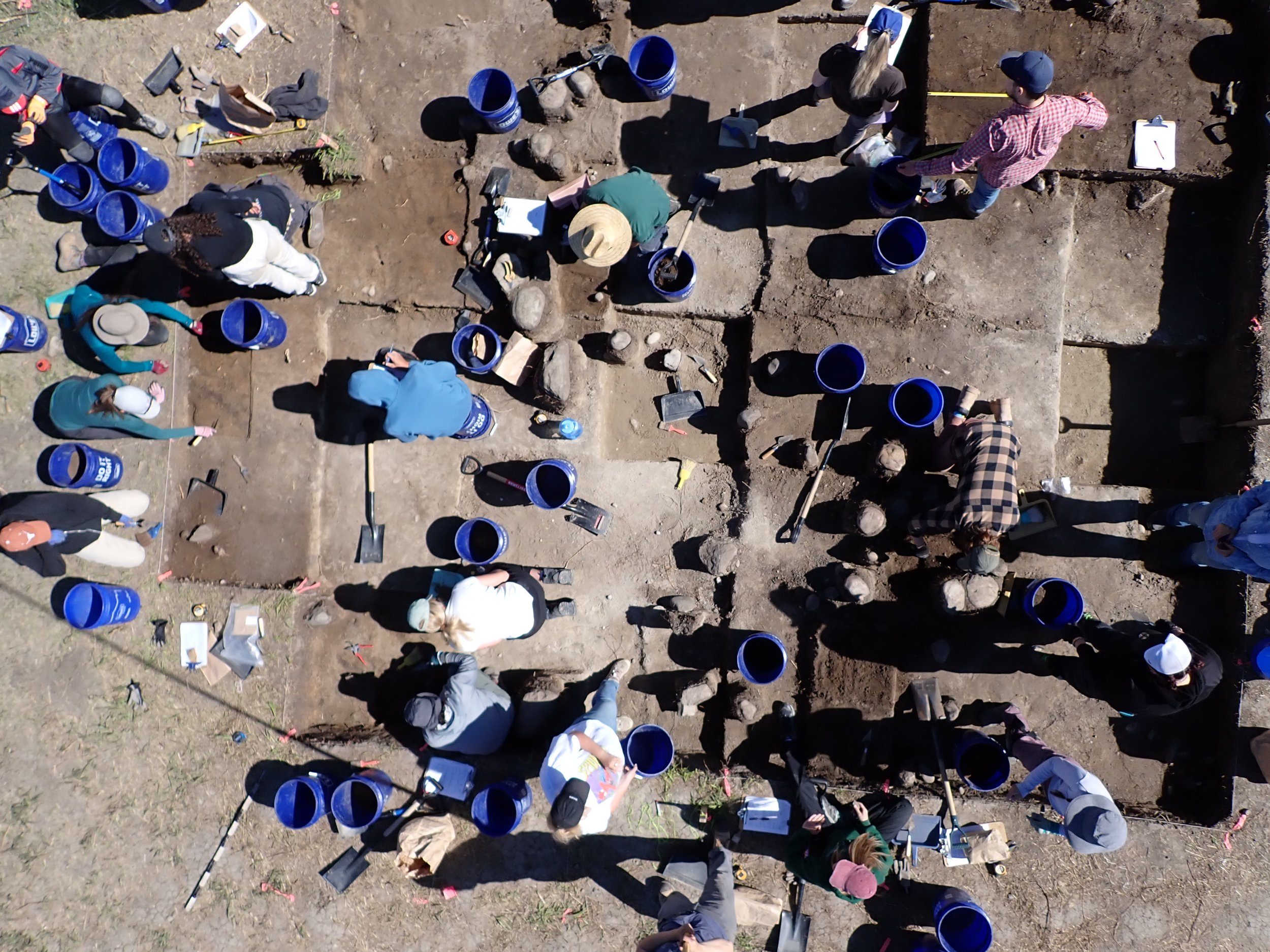2024 Heritage Calgary Awards, Cultural Landscapes - Public Archaeology Program, University of Calgary
2024 Heritage Calgary Awards
University of Calgary Staff and Students at Nose Hill Park. Source: Dr. Lindsay Amundsen-Meyer.
Winner of the 2024 Heritage Calgary Award,
Cultural Landscapes:
Public Archaeology Program, University of Calgary
The University of Calgary Public Archaeology Program aims to introduce Alberta’s heritage to a broader audience by involving members of the public and Indigenous Peoples in archaeological education and practice. The program brought members of the public, Indigenous knowledge keepers and University of Calgary students together to study and participate in a dig at Calgary’s Nose Hill Park.
Roughly 15,000 years ago, Nose Hill stood above Glacial Lake Calgary and has been a site visited and inhabited by Indigenous People for thousands of years. The excavation site was a stone circle site in the park. Participants began with a heritage walking tour of the site and surrounding area. The walk was facilitated by two graduate students in archeology and a research assistant from Siksika Nation.
To learn more, Heritage Calgary connected with Dr. Lindsay Amundsen-Meyer, an Assistant Professor in Archaeology and the Public Archaeology Program Director.
Can you describe the main goal of your initiative and the inspiration behind it?
The primary goal of the Public Archaeology Program is to increase awareness among the average public of the long-term history, Indigenous history of this place, and to foster intercultural empathy, understanding, and respect.
Excavations of the stone circle site at Nose Hill Park. Source: Dr. Lindsay Amundsen-Meyer
What makes this project or site particularly significant to the local community and its history?
Nose Hill itself is a very important urban space. It's Calgary's largest urban park and people use it every day, but most people don't realize how long it has been an important place for human groups.
I think that's really the key piece for us this year was that it's a space that's well known in a settler context, but being able to demonstrate that this place has been used for at least 8,000 years, if not longer. It increases the awareness of the average Calgarian about how long this place has been important to past peoples.
How has this initiative helped engage the public or specific groups, such as youth or residents, in the project?
One way is we have public program participants who are able to come and dig right alongside our University of Calgary field school students and learn about history that way. University of Calgary students are also getting that experience alongside members of the public.
Along with that, we've also been offering school programs too, actually, so that we have what we call an Indigenous Youth Engagement Program where grade 7 to 12 students actually get the same opportunity. They're getting our grad students going into their classrooms to teach them about archaeology and then they come out and dig with us as well.
What challenges or considerations did you face in preserving or promoting local heritage through this initiative?
I think the biggest thing is that things like built heritage are a lot more visible. People are a lot more aware of a historic building because it's right there for all to see. One elder I work with talks about how she's always thought about how far people ranged on the land, but she never really thought about looking below the land. We're looking into the ground and we're seeing that history of use layered up, one on top of the other.
Most Calgarians and people don't know that. That became quite clear when we were at Nose Hill. There are people that use that park every single day and they had no idea that there are archaeological sites at Nose Hill at all.
Why do you think it's important for people to understand and appreciate the history and heritage of this particular area?
In the era of truth and reconciliation, the first step is really truth and education. We can't build to reconciliation until we get a solid understanding both of the history of the place and also the truth of what's happened to the Indigenous people that were here since time immemorial. This really is kind of one step in starting with truth and with education.
Looking forward, how do you see this project continuing or evolving in the future to engage more people or further preserve local heritage?
So our hope is we'll do it again. We're also hopefully going to work with Calgary Parks this coming spring to do another program. And I think continuing to do public engagement to get information out there and to partner with nations and Indigenous storytellers. I'm an archaeologist. I can tell you the archaeological side of the story, but there's so much rich cultural information that ties into that from all of the nations that have called Southern Alberta home. If we can bring those pieces together, that's where we're all going to learn the most.
The Heritage Calgary Awards celebrate the diverse heritage of our shared home. Every second year we honour those who have made efforts to identify, preserve, and promote heritage in Calgary to help enrich our communities.


